
The National Autonomous University of Mexico is a public research university in Mexico. It ranks highly in world rankings based on the university's extensive research and innovation. It is the largest university in Latin America and has one of the biggest campuses in the world. UNAM's main campus in Mexico City, known as Ciudad Universitaria, is a UNESCO World Heritage site that was designed by some of Mexico's best-known architects of the 20th century. Murals in the main campus were painted by some of the most recognized artists in Mexican history, such as Diego Rivera and David Alfaro Siqueiros. In 2016, it had an acceptance rate of only 8%. UNAM generates a number of strong research publications and patents in diverse areas, such as robotics, computer science, mathematics, physics, human-computer interaction, history, philosophy, among others. All Mexican Nobel laureates are either alumni or faculty of UNAM.

Antigua Guatemala, commonly referred to as just Antigua or la Antigua, is a city in the central highlands of Guatemala known for its preserved Spanish Baroque-influenced architecture as well as a number of ruins of colonial churches. It served as the capital of the Kingdom of Guatemala. It has been designated a UNESCO World Heritage site.
Ricardo Legorreta Vilchis was a Mexican architect. He was a prolific designer of private houses, public buildings and master plans in Mexico, the United States of America and some other countries.

Agustín Yáñez Delgadillo was a notable Mexican writer and politician who served as Governor of Jalisco and Secretary of Public Education during Gustavo Díaz Ordaz's presidency. He is the author of numerous books and the recipient, in 1952 as member of the Academia Mexicana de la Lengua, in 1973, of the Premio Nacional de las Letras. Al filo del agua is universally acknowledge as his masterpiece, according to the Encyclopedia of Latin American and Caribbean literature, 1900-2003 By Daniel Balderston, Mike Gonzalez, page 616.
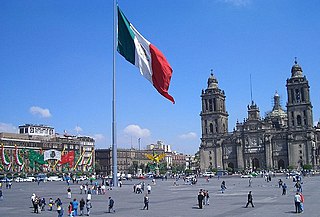
The historic center of Mexico City, also known as the Centro or Centro Histórico, is the central neighborhood in Mexico City, Mexico, focused on Zócalo or main plaza and extending in all directions for a number of blocks, with its farthest extent being west to the Alameda Central. The Zocalo is the largest plaza in Latin America. It can hold up to nearly 100,000 people.
Mario Pani Darqui was a famous Mexican architect and urbanist. He was one of the most active urbanists under the Mexican Miracle, and gave form to a good part of the urban appearance of Mexico City, with emblematic buildings, such as the main campus of the UNAM, the Unidad Habitacional Nonoalco-Tlatelolco, the Normal School of Teachers (Mexico), the National Conservatory of Music and other big housing projects called multifamiliares. His son Knut is a well-known artist.

The School of Architecture at UNAM is one of the leading schools of architecture and design in Mexico. It offers undergraduate and postgraduate studies in architecture, landscape architecture, urbanism and industrial design.
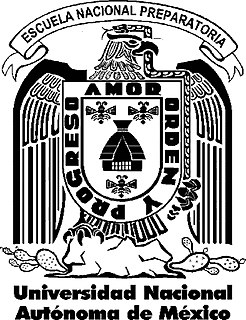
The Escuela Nacional Preparatoria (ENP), the oldest senior High School system in Mexico, belonging to the National Autonomous University of Mexico (UNAM), opened its doors on February 1, 1868. It was founded by Gabino Barreda, M.D., following orders of then President of Mexico Benito Juárez. It is also modern UNAM's oldest institution.
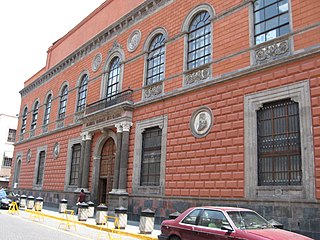
The Academy of San Carlos is located at 22 Academia Street in just northeast of the main plaza of Mexico City. It was the first major art academy and the first art museum in the Americas. It was founded in 1781 as the School of Engraving and moved to the Academia Street location about 10 years later. It emphasized classical European training until the early 20th century, when it shifted to a more modern perspective. At this time, it also integrated with the National Autonomous University of Mexico, eventually becoming the Faculty of Arts and Design, which is based in Xochimilco. Currently, only graduate courses of the modern school are given in the original academy building.

Sebastián is a Mexican sculptor best known for his monumental works of steel and/or concrete in both Mexico and abroad. These include a number of “gate” sculptures such as the Gran Puerta a México in Matamoros, Tamaulipas but his most famous sculpture is the “Caballito” located in downtown Mexico City. His works are found in various cities outside Mexico, such as Japan where two are now used as city symbols.

San Ildefonso College currently is a museum and cultural center in Mexico City, considered to be the birthplace of the Mexican muralism movement. San Ildefonso began as a prestigious Jesuit boarding school, and after the Reform War it gained educational prestige again as National Preparatory School. This school and the building closed completely in 1978, then reopened as a museum and cultural center in 1992. The museum has permanent and temporary art and archeological exhibitions in addition to the many murals painted on its walls by José Clemente Orozco, Fernando Leal, Diego Rivera and others. The complex is located between San Ildefonso Street and Justo Sierra Street in the historic center of Mexico City.
Carlos G. Mijares Bracho was a Mexican architect and founder of the "grupo Menhir".
Augusto Harold Álvarez García was a Mexican Modernist architect.
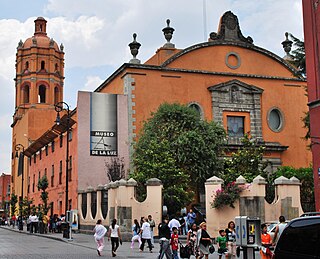
The San Pedro y San Pablo College colonial church and school complex built in late 16th and early 17th centuries, located in the historical center of Mexico City district of Mexico City, Mexico.
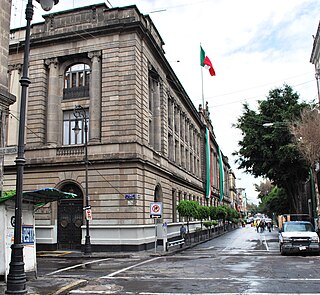
The Secretariat of Public Education Main Headquarters building is on the northeast corner of San Ildefonso and República de Argentina streets in the historic center of Mexico City, and used to be part of the largest and most sumptuous convents in New Spain. It was secularized in the 19th century and then taken over by the then-new Secretariat of Public Education after the Mexican Revolution in the early 20th century. The new agency did extensive remodeling work on the building, including covering nearly all the walls of the two inner courtyards with murals. These murals include Diego Rivera’s first large-scale mural project, which he completed in 1928.
Clementina Díaz y de Ovando was a Mexican writer, researcher, and academic specialised in New Spain's art and architecture.

The Palacio de la Autonomía is a museum and site where the Universidad Nacional Autónoma de México gained autonomy from direct government control in 1929. The building is from the late 19th century, and located on the corner of Licenciado de Verdad and Rep de Guatemala streets, north of Santa Teresa la Antigua and east of Templo Mayor. The site has a 500-year history, starting from part of lands granted by Hernán Cortés. The current building was constructed by the administration of President Porfirio Díaz, but it was ceded to the University in 1910. Since that time, the building has had a number of uses, including housing a dental school and a preparatory school. Today it houses the Museo de la Autonomía Universitaria.
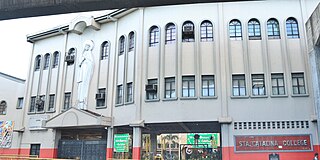
Santa Catalina College is a private sectarian educational institution located in Sampaloc, Manila. It is being administered by the Congregation of the Dominican Sisters of St. Catherine of Siena, a congregation affiliated with the Dominican Order of the Roman Catholic Church.













